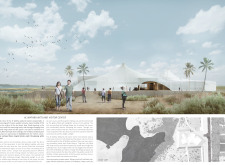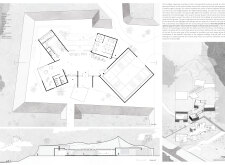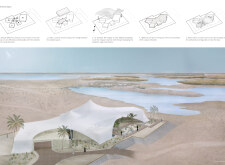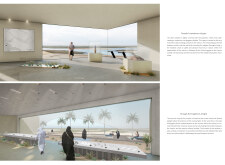5 key facts about this project
The Al Wathba Wetland Visitor Center is located in Abu Dhabi, designed to connect people with the unique natural landscape of the Al Wathba wetlands. This facility serves an educational purpose, allowing visitors to learn about the importance of this specific habitat. The design concept focuses on merging the built environment with the wetlands, creating a space that reflects the relationship between architecture and nature.
Structural Design
The visitor center includes a central gathering area that is illuminated by fragmented skylights. These openings allow natural light to enter, enhancing the overall atmosphere inside. This central hall serves as the main space of the facility, encouraging visitors to explore and engage with the exhibitions while creating a warm inviting setting.
Environmental Integration
A tent-like structure provides shade from the intense desert sun, creating a cooler environment for visitors. This design choice mirrors the natural forms found in the wetlands, offering comfort while highlighting the surrounding ecology. The distinct arrangement of the building volumes promotes a dialogue between the architecture and the natural landscape, enhancing the visitor's experience.
Material Selection
Natural sand bricks are used for the exterior walls, which help with ventilation and allow natural light to brighten the interior spaces. This choice of material supports the project's focus on sustainability and connection to the environment. The outer layer also features a metal mesh that provides a view into the wetlands and adds to the building's durability. The combination of materials creates a sense of transparency and emphasizes the importance of the landscape to the overall design.
Visitor Experience
The layout encourages visitors to engage with the environment, with galleries designed to provide clear views of the diverse wildlife in the wetlands. As people move through the center, they gain an understanding of the delicate balance that exists within this ecosystem. Each aspect of the design is carefully considered to enrich the educational journey, allowing for deeper appreciation of the wetlands and their critical role in environmental health.
Visitors find themselves in a space where the lines between indoors and outdoors blur, culminating in an expansive view of the thriving wetland ecosystem that invites curiosity and respect for the natural world.






















































